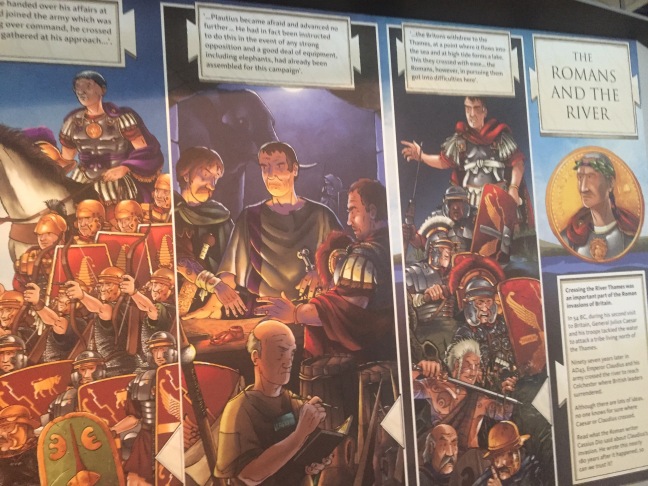REFLECTIVE BLOG
Monday, June 29, 2015
After visiting the archives of the Museum of London, getting to see the exhibitions was a real treat. I’m forewarning you though, this may get a bit dry for some readers. It’ll be discussing the exhibition layout of the Museum of London. It won’t hurt my feelings if you’re just here to see my personal blog posts and feel like skipping this one! If you are interested in my thoughts comparing museums and libraries, though… read on!
I thought the artefacts were displayed in a manner that engaged all audiences, from children to adults. There were texts blocks that asked questions of the reader, such as, “What do you think this object was meant to do?” or “Why is this decorated in such a way?” It lets the patrons know that even the professionals don’t have all the answers and crowdsourcing can be effective.
The Prehistoric Section showed animal bones with little pictures of comparative size with a human. See just to the left of the aurouch’s skull?

Dioramas were used to show how to cross a marsh.

Sketches showed what they think people looked like in the time period.

Videos played to give a sense of how the objects were used in everyday life.

Computers were scattered around the exhibit halls to allow patrons to search their catalog. You’ll find the online collection catalog link here.

Wall murals in the style of comics or graphic novels depicted Roman London.

Timelines helped place important events.

Life-size recreations gave patrons full access and interaction. The building is complete with environmental sounds of cooking and animals. (Sidenote: I was sitting in the back corner when a cow suddenly mooed from behind me… I nearly jumped out of my skin, but it was exciting! It got my heart pumping at least!)

Again, more models. This one is of St. Paul’s Cathedral before the Great Fire of 1666.

Video screens are strategically placed to show the importance of the printing press.

This exhibit of a Victorian table setting is actually in the floor. Faintly you can see my foot along the bottom edge…

And an interactive projected screen… that’s video cannot be posted right now. (Coming soon?)
All of these exhibit styles add to the experience of being in the museum. They help time pass quicker and hopefully make it more interesting to learn about the items being showcased. Realize that these techniques picture above are mainly for museum artefacts; libraries usually deal with books and manuscripts. Texts are interactive, but not in the way that tea cups can be arranged on a table for a patron’s viewing pleasure. (Personally I like the arrangements of books on tables and shelves, but I feel in the minority on that. Must come with being a bibliophile…)
Presently, I don’t feel as if there is much dialog between libraries and museums when they do much of the same things. Both preserve materials for the public and future research. Books are used as reference materials and must be engaged with (read) to receive the full experience of the item , though. How can libraries use the techniques of museums to create more interactive exhibits?
Technology. Technology is an area that many libraries are utilizing in their exhibits to make them more interactive and “exciting.” Video monitors, projections, short movies, recordings, and touch screen computers are things that I’ve begun to see in libraries. Not only do they allow for more interaction with the objects, they preserve the materials in a way too. If I have an interactive monitor with a fully digitized book on the screen, patrons can flip through that book all day long without actually touching the pages of the book furthering it’s life expectancy in a way.
My thoughts on this topic are still turning and haven’t quite settled… These were ideas thought of while walking through the exhibits, so let me know yours below!
